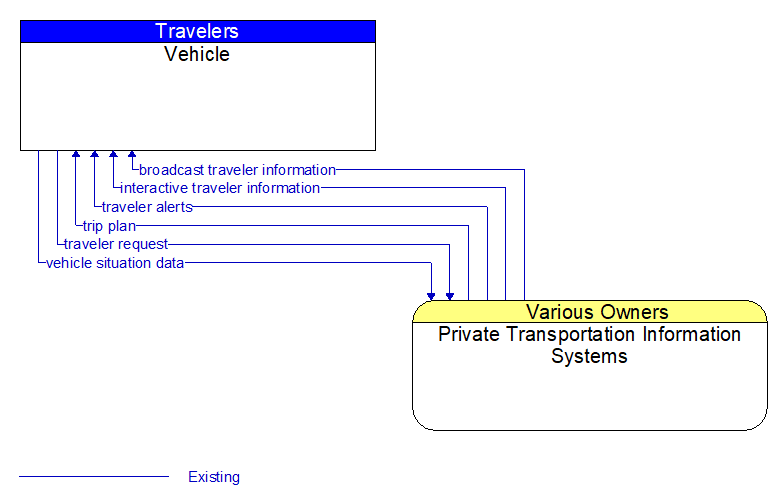Interface: Vehicle - Private Transportation Information Systems

Architecture Flow Definitions
broadcast traveler information (Existing) Applicable ITS Standards
General traveler information that contains traffic and road conditions, link travel times, incidents, advisories, restrictions, transit service information, weather information, parking information, and other related traveler information.
interactive traveler information (Existing) Applicable ITS Standards
Traveler information provided in response to a traveler request. The provided information includes traffic and road conditions, advisories, incidents, payment information, transit services, parking information, weather information, and other travel–related data updates and confirmations.
traveler alerts (Existing) Applicable ITS Standards
Traveler information alerts reporting congestion, incidents, adverse road or weather conditions, parking availability, transit service delays or interruptions, and other information that may impact the traveler. Relevant alerts are provided based on traveler–supplied profile information including trip characteristics and preferences.
traveler request (Existing) Applicable ITS Standards
A request for traveler information including traffic, transit, toll, parking, road weather conditions, event, and passenger rail information. The request identifies the type of information, the area of interest, parameters that are used to prioritize or filter the returned information, and sorting preferences.
trip plan (Existing) Applicable ITS Standards
A travel itinerary identifying a route and associated traveler information and instructions identifying recommended modes and transfer information, ride sharing options, and transit and parking reservation information.
vehicle situation data (Existing) Applicable ITS Standards
This flow represents vehicle snapshots that may be provided by the vehicle to support traffic and environmental conditions monitoring. Snapshots are collected by the vehicle for specific events (e.g., when a sensor exceeds a threshold) or periodically and reported based on control parameters when communications is available. Traffic–related data includes snapshots of measured speed and heading and events including starts and stops, speed changes, and other vehicle control events. Environmental data may include measured air temperature, exterior light status, wiper status, sun sensor status, rain sensor status, traction control status, anti–lock brake status, and other collected vehicle system status and sensor information. The collected data is reported along with the location, heading, and time that the data was collected.